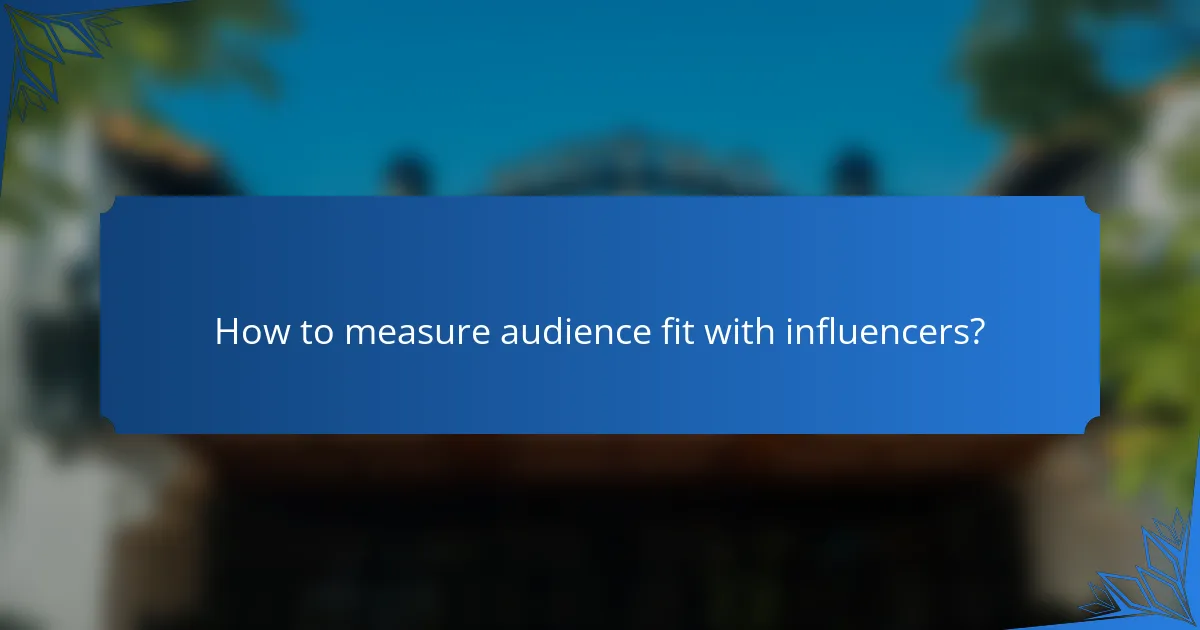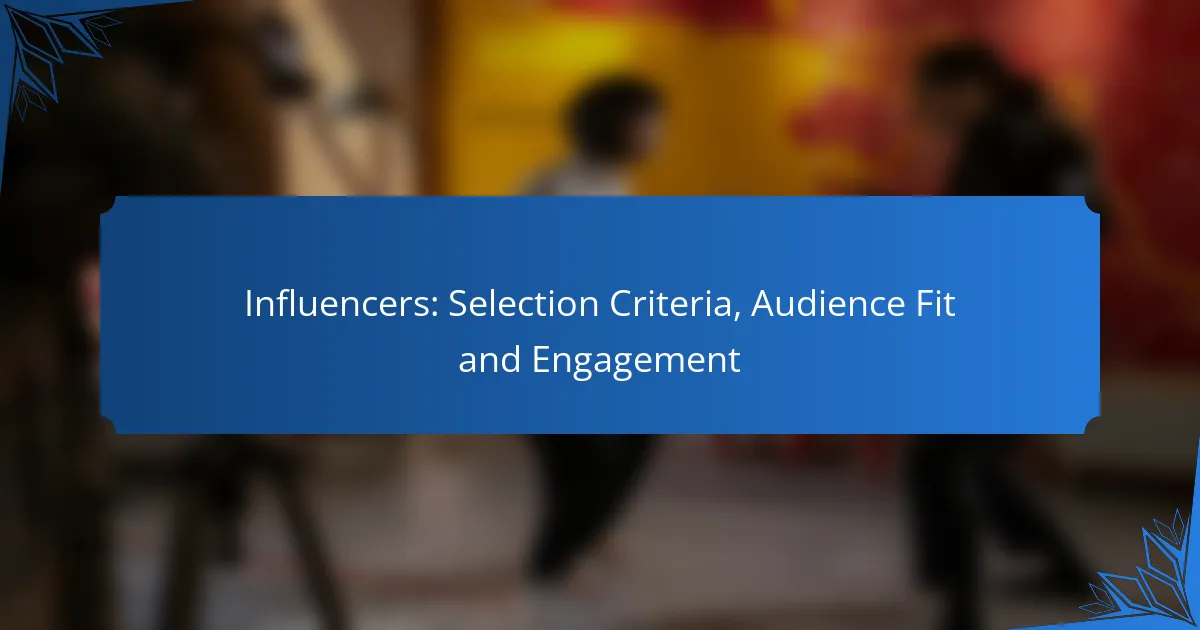Choosing the right influencers for your marketing strategy is crucial for maximizing engagement and brand visibility. It requires a careful evaluation of audience demographics, engagement metrics, and the influencer’s relevance to your niche. By focusing on these selection criteria, brands can ensure that their collaborations resonate with the intended audience and align with overall marketing goals.

How to select the right influencers for display advertising?
Selecting the right influencers for display advertising involves understanding your target audience and ensuring the influencer’s reach aligns with your brand goals. Focus on audience demographics, niche relevance, engagement metrics, past collaborations, and brand alignment to make informed decisions.
Identify audience demographics
Understanding audience demographics is crucial for selecting influencers who can effectively reach your target market. Consider factors such as age, gender, location, and interests to ensure alignment with your brand’s objectives.
For example, if your product appeals primarily to young adults aged 18-24, look for influencers whose followers predominantly fall within this age range. Tools like social media analytics can provide insights into an influencer’s audience composition.
Evaluate niche relevance
Niche relevance refers to how closely an influencer’s content aligns with your brand’s industry or product category. Selecting influencers who specialize in your niche ensures that their audience is more likely to engage with your advertising.
For instance, a fitness brand should collaborate with health and wellness influencers rather than general lifestyle influencers. This targeted approach increases the likelihood of conversions and brand loyalty.
Assess engagement metrics
Engagement metrics, such as likes, comments, shares, and overall interaction rates, provide insight into how actively an influencer’s audience engages with their content. High engagement rates often indicate a loyal and interested follower base.
Look for influencers with engagement rates above industry averages, typically around 1-3% for larger accounts and higher for smaller ones. This can help you gauge the potential effectiveness of your advertising efforts.
Review past collaborations
Examining an influencer’s past collaborations can reveal their effectiveness and reliability. Look for case studies or testimonials that demonstrate successful campaigns and positive outcomes for brands similar to yours.
Consider the types of products they have promoted and the feedback received. Influencers who have successfully partnered with brands in your industry are more likely to understand your needs and deliver results.
Consider brand alignment
Brand alignment is about ensuring that the influencer’s values, style, and messaging resonate with your brand identity. Collaborating with influencers who share similar values can enhance authenticity and trust with your audience.
For example, if your brand emphasizes sustainability, partnering with eco-conscious influencers can strengthen your message. Evaluate their content to ensure it reflects your brand’s ethos and mission.

What criteria should be used for influencer selection?
When selecting influencers, focus on their follower count, engagement rates, content quality, and authenticity. These criteria help ensure that the influencer aligns with your brand and effectively reaches your target audience.
Follower count and growth rate
Follower count provides a basic measure of an influencer’s reach. However, it’s essential to consider the growth rate as well; a rapidly growing follower base may indicate increasing popularity and relevance. Look for influencers with tens of thousands to millions of followers, but prioritize those who show consistent growth over time.
Monitoring follower growth can be done using social media analytics tools, which can reveal trends and spikes in follower acquisition. This data helps assess whether an influencer is gaining traction in their niche.
Engagement rate analysis
Engagement rate is a critical metric that reflects how actively followers interact with an influencer’s content. A higher engagement rate, typically in the range of 1% to 5%, suggests that the audience is genuinely interested and likely to respond to brand promotions.
To calculate engagement rate, divide the total interactions (likes, comments, shares) by the total follower count, then multiply by 100. This figure can help you compare influencers and choose those who foster meaningful connections with their audience.
Content quality and style
The quality and style of an influencer’s content should align with your brand’s image and messaging. Review their posts for visual appeal, originality, and relevance to your target demographic. High-quality content often leads to better audience retention and brand perception.
Consider creating a checklist of desired content attributes, such as professionalism, creativity, and consistency in theme. This will help streamline your selection process and ensure a good fit with your brand identity.
Authenticity and trustworthiness
Authenticity is vital for influencer marketing success. Audiences are more likely to engage with influencers who appear genuine and relatable. Look for influencers who share personal stories and maintain transparency about partnerships and sponsorships.
Check for signs of trustworthiness, such as positive audience feedback, consistent messaging, and a history of ethical practices. Engaging with influencers who prioritize authenticity can enhance your brand’s credibility and foster stronger connections with potential customers.

How to measure audience fit with influencers?
Measuring audience fit with influencers involves assessing how well their followers align with your target demographic. This ensures that collaborations resonate with potential customers and enhance brand visibility.
Analyze audience overlap
Start by comparing the demographics of the influencer’s audience with your own target market. Look for similarities in age, gender, location, and interests to determine the potential for engagement. Tools like Google Analytics and social media insights can provide valuable data on audience characteristics.
Consider using Venn diagrams to visualize audience overlap. This can help you identify shared segments and tailor your messaging to appeal to both audiences effectively.
Utilize social listening tools
Social listening tools allow you to monitor conversations and sentiments around both your brand and the influencer. Platforms like Hootsuite or Brandwatch can track mentions, hashtags, and engagement metrics to gauge how well the influencer’s audience interacts with similar content.
Pay attention to the context of discussions to understand audience interests and preferences. This insight can inform your strategy and help you select influencers whose followers are likely to engage with your brand.
Conduct surveys and feedback
Surveys can provide direct insights into audience perceptions and preferences. Consider creating short questionnaires for your existing customers to gather feedback on potential influencers. Ask about their familiarity with the influencer and their interest in related products or services.
Additionally, engaging with the influencer’s audience through polls or feedback forms can yield valuable information. This approach allows you to assess their interests and how well they align with your brand’s offerings.

What are the best practices for influencer engagement?
Effective influencer engagement hinges on clear communication, mutual understanding, and creative collaboration. By establishing guidelines and fostering an open dialogue, brands can build strong partnerships that resonate with audiences.
Develop clear collaboration guidelines
Clear collaboration guidelines set the foundation for successful influencer partnerships. These guidelines should outline expectations regarding content type, posting schedules, and brand messaging to ensure alignment between the influencer and the brand.
Consider creating a document that includes key points such as deliverables, deadlines, and compensation details. This can help prevent misunderstandings and keep both parties accountable throughout the collaboration.
Foster open communication
Open communication is essential for maintaining a healthy relationship with influencers. Regular check-ins can help address any concerns and provide opportunities for feedback, ensuring that both parties remain aligned on goals and expectations.
Utilize various communication tools, such as email, messaging apps, or video calls, to facilitate discussions. Encourage influencers to share their thoughts and ideas, as this can lead to more authentic and engaging content that resonates with their audience.
Incorporate creative freedom
Allowing influencers creative freedom can enhance the authenticity of the content they produce. Influencers understand their audience best, so giving them the flexibility to express their unique style can lead to more genuine engagement.
While it’s important to provide brand guidelines, avoid micromanaging the creative process. Trusting influencers to craft content that aligns with their voice can result in higher engagement rates and a more effective partnership.

How to evaluate the effectiveness of influencer campaigns?
Evaluating the effectiveness of influencer campaigns involves assessing various metrics that indicate success, such as conversion rates, brand awareness, and engagement levels. By analyzing these factors, brands can determine the return on investment and overall impact of their influencer partnerships.
Track conversion rates
Conversion rates are a critical metric for measuring the effectiveness of influencer campaigns. This metric indicates the percentage of users who take a desired action, such as making a purchase or signing up for a newsletter, after engaging with influencer content. To track conversion rates, use unique discount codes or affiliate links specific to each influencer.
Consider setting benchmarks based on industry standards, which often range from 1% to 5% for e-commerce campaigns. Regularly monitor these rates to identify trends and adjust strategies accordingly.
Measure brand awareness impact
Brand awareness impact can be gauged through metrics such as reach, impressions, and social media mentions. These indicators help assess how many people were exposed to the brand through influencer content. Surveys can also be conducted pre- and post-campaign to measure shifts in brand recognition and perception.
Utilizing tools like Google Analytics or social media analytics can provide insights into traffic sources and audience demographics, helping to refine future influencer selections based on awareness outcomes.
Analyze engagement post-campaign
Post-campaign engagement analysis focuses on interactions such as likes, shares, comments, and overall sentiment towards the content. High engagement rates typically indicate that the audience resonated with the influencer’s message. Compare engagement metrics against previous campaigns to identify what worked well and what didn’t.
Consider using engagement rates as a percentage of total followers to better understand the effectiveness relative to the influencer’s audience size. Aim for engagement rates above 2% for meaningful interactions, adjusting strategies based on these insights for future campaigns.

What frameworks can help in influencer selection?
Frameworks for influencer selection provide structured approaches to identify and evaluate potential influencers based on specific criteria. These frameworks help brands align their marketing goals with the right influencers to maximize engagement and audience fit.
Audience Analysis
Audience analysis is crucial for selecting the right influencer. It involves understanding the demographics, interests, and behaviors of an influencer’s followers. Brands should look for influencers whose audience aligns closely with their target market to ensure effective communication and engagement.
Tools like social media analytics and audience insights can help brands assess follower demographics. For example, if a brand targets young professionals, they should prioritize influencers with a significant following in that age group and related interests.
Engagement Metrics
Engagement metrics are key indicators of an influencer’s effectiveness. These include likes, comments, shares, and overall interaction rates on their content. High engagement rates suggest that an influencer’s audience is active and responsive, which can lead to better campaign outcomes.
Brands should consider engagement rates over sheer follower counts, as a smaller, highly engaged audience often yields better results than a large but passive one. A good benchmark is an engagement rate of 1% to 3% for most industries.
Content Alignment
Content alignment refers to how well an influencer’s content style and values match those of the brand. Selecting influencers whose content resonates with the brand’s messaging ensures authenticity and credibility in campaigns. This alignment can enhance the overall effectiveness of marketing efforts.
Brands should review an influencer’s previous posts to assess their tone, style, and subject matter. For instance, a sustainable fashion brand should collaborate with influencers who promote eco-friendly lifestyles and products.
Reputation and Authenticity
Reputation and authenticity are vital factors in influencer selection. Brands should research an influencer’s past collaborations and public perception to ensure they maintain a positive image. Authentic influencers who genuinely connect with their audience can drive more impactful results.
Checking for any controversies or negative feedback can help brands avoid potential pitfalls. Engaging with influencers who have a transparent and honest approach fosters trust and strengthens brand credibility.



